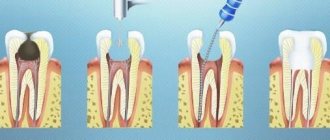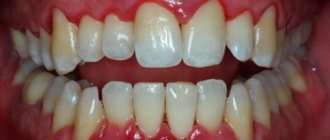- Causes
- Diagnostics
- Symptoms
- Treatment
- Prevention
If a patient complains that his teeth have increased sensitivity, the doctor usually diagnoses “enamel hyperesthesia.” This disease means high sensitivity of teeth to temperature, chemical and mechanical stimuli.
This phenomenon is quite common; hyperesthesia of hard dental tissues is diagnosed in almost every second visitor.
Tooth sensitivity can be either an independent disease or a concomitant symptom of caries, enamel erosion, periodontal disease, increased abrasion of tooth enamel or wedge-shaped defect. Most often, severe sensitivity annoys patients with non-carious lesions of dental tissues, in which the enamel layer becomes thinner and dentin is exposed.
Sensitivity of tooth enamel is also observed with carious lesions. In this case, there may be no external manifestations of caries, but the painful reaction of the tooth to thermal or chemical irritants should alert both the patient and the doctor, because perhaps this is one of the first signs of incipient caries.
Increased sensitivity of the neck of the tooth can also be a symptom of periodontal disease, in which the neck of the teeth becomes exposed and reacts with acute pain to hot or cold food.
Typically, patients complain that the tooth feels cold and hot, and the nature of the pain can be very diverse - from acute intense but quickly passing pain in a single tooth to long-term dull pain in the area of several at once. Most often, patients note increased sensitivity to hot, cold, sweet and sour. At the site of dislocation, sensitivity of the teeth is usually noted near the gums, at the base of the tooth.
Causes
The causes of dental hyperesthesia can be very diverse, ranging from mechanical damage to the surface of tooth enamel and ending with general disturbances in the functioning of the human body. The most common causes of enamel hyperesthesia are:
- damage to tooth enamel by short-term exposure to organic or mineral acids;
- exposure of dentinal canals as a result of carious and non-carious lesions of teeth;
- disruptions in the functioning of the endocrine system as a result of pregnancy or menopause;
- disturbances of phosphorus-calcium metabolism in the human body;
- previously suffered general or neuropsychological diseases of the human body;
- exposure to ionizing radiation on the human body;
- habit of eating a lot of sour berries, fruits, juices, fruit drinks.
Sensitive tooth enamel occurs when the dentinal tubules become exposed for one or more reasons and a variety of irritants affect the sensitivity of the pulp. In this case, even simple inhalation of cold air or brushing your teeth can cause painful sensations. Teeth in the cervical area are especially sensitive, because the enamel is thinnest there, and if the gum moves away from the tooth, it almost immediately begins to react sharply to various irritants.
Separately, we should dwell on the mechanism of hyperesthesia. As you know, dentin is penetrated by many tiny tubes - the so-called dentinal canals, in which there are processes of nerve cells that are connected to the pulp. Dentinal tubules are filled with fluid that is in constant motion. Any change in the speed of fluid movement causes a pain reaction.
If the enamel is thinned, this leads to exposure of the dentinal tubules, and under the influence of various irritants, the speed of fluid movement in the dentinal tubules constantly changes, causing acute short-term pain, as a result of which the patient complains of very sensitive teeth.
Why can a tooth react to heat?
As a rule, increased tooth sensitivity develops gradually. In the clinical picture of hyperesthesia, three degrees are distinguished.
- I – the tooth reacts only to a temperature stimulus, i.e. hot or cold.
- II – the reaction occurs to a temperature stimulus and a chemical effect, i.e. for sour, sweet or salty.
- III – teeth react painfully to any irritants, including tactile ones, for example, to the impact of a toothbrush.
However, it is not always possible to determine the exact cause of increased sensitivity on your own. Especially if a pulpless tooth hurts, without a nerve, which, logically, is dead and should not bother you at all. In this case, you should not experiment with self-medication, but rather consult a dentist. An experienced clinic specialist will identify the cause - determine why the tooth hurts and provide adequate treatment for the pathology. In most clinical cases, the development of hyperesthesia occurs under the influence of the following reasons.
Carious process
Caries causes focal demineralization of the enamel, which leads to thinning and subsequent destruction of the hard tissues of the tooth. As a result of the pathological process, a cavity is formed in the dentin, thereby opening access to external irritants directly to the dental pulp. Without treatment, advanced caries causes pain, leads to pulpitis, periodontitis and, ultimately, tooth loss.
Increased tooth wear
The pathology is characterized by non-carious damage to the hard tissues of the tooth, in which their intensive loss is observed. They literally wear away, which leads to dentin exposure and is accompanied by pain. Among the causes of pathology are malocclusions, wearing an incorrectly selected denture, bruxism, excessive load on the dentition due to the loss of one or more teeth, and insufficient hardness of dental tissues. Increased abrasion occurs with fluorosis, hormonal disorders and regular exposure to negative environmental factors, for example, in professions associated with hazardous production.
Mechanical damage to enamel
In this case, everything is quite simple - cracks, chips and other damage formed on the surface of the tooth facilitate the penetration of external irritants to the nerves of the pulp. This problem is typical for both front and molar teeth.
Wedge-shaped defect
Non-carious lesion of the hard tissues of the tooth, in which a characteristic wedge-shaped defect is formed in the cervical area. Among the main causes of pathology are poor oral hygiene, regular mechanical damage to the enamel with a toothbrush and the development of periodontitis. The defect formed as a result of their influence is the thinnest and most vulnerable place in the enamel and dentin, through which external irritants easily affect the nerves of the pulp.
Hypoplasia
The pathology is characterized by underdevelopment of hard tissues or the entire tooth as a whole. With it, part of the enamel is missing, and in more severe cases, part of the dentin, which naturally causes pain. Hypoplasia is formed during fetal development or at an early age, arising as a result of metabolic disorders. It is irreversible and leads to bite pathologies, increased abrasion and complete destruction of hard tissues. The only way out is to fill the tooth or place it under a crown, thereby protecting it from the negative effects of environmental factors.
Erosion of tooth enamel
Non-carious lesion, characterized by damage to enamel and (or) dentin. The main reason for the development of pathology has not been clearly determined to date. Experts tend to consider the basis for its development to be mechanical stress during brushing teeth, abuse of citrus fruits, hormonal disorders and natural aging of the body. Often, erosion is not noticeable externally and invariably leads to increased sensitivity of the teeth. Without treatment, it grows to such an extent that the teeth begin to react not only to hot or cold food (drinks), but also to sudden changes in ambient temperatures - heat and frost. After filling, installation of a crown or veneer, it goes away.
Necrosis
Necrosis of hard dental tissues is caused by a number of reasons. Exposure to acids and alkalis, radiation therapy, hormonal disorders, intoxication of the body, diseases of the central nervous system - these and other factors lead to the necrosis of the enamel that protects the tooth. It becomes painful, breaks down and needs immediate treatment.
Periodontal diseases
Periodontium is the periodontal tissue that holds the tooth in the alveolus. They are permeated with a large number of nerves and react to the slightest stimuli. Therefore, the direct impact on the periodontium, in itself, is painful, not to mention the fact that its pathologies (inflammation) lead to tooth loss.
Other reasons
In this case, we are talking about the influence of external factors that could lead to damage to the hard tissues of the tooth. As a rule, they are associated with the provision of low-quality dental services, errors in care or nutrition of the person himself. The most likely reasons for the development of hyperesthesia are the following.
- Whitening procedures can cause thinning of tooth enamel.
- Filling – leads to mechanical damage and thinning due to etching of the area to be filled with acids to improve adhesion.
- Prosthetics – a pin for installing a crown or an incorrectly selected prosthesis can cause damage to the hard tissues of the tooth.
- Removal of a nerve - an incompletely removed nerve or poorly sealed canals can signal hyperesthesia.
- Improper care - unsuitable toothpaste, too hard brush, aggressive brushing lead to microdamage to tooth enamel and its thinning.
- Deficiency of minerals and vitamins - a lack of calcium, fluorine, magnesium, vitamin D and C in the human body provokes the destruction of enamel and hard tooth tissues. This problem is especially relevant at an early age, during pregnancy and aging.
It is important to understand! If a tooth reacts to hot (cold) or begins to hurt for no apparent reason, then there is no need to self-medicate. It is better to consult a dentist who will help to promptly identify the cause of increased sensitivity and eliminate it. Because all home remedies are nothing more than a temporary measure that does not solve the problem or cure dental pathologies. Temporary pain relief may result in serious complications and tooth loss.
Diagnostics
If a patient complains of tooth sensitivity to cold, hot, sweet and sour foods, the doctor may immediately suspect hyperesthesia. The disease can be diagnosed after a visual examination of the patient's oral cavity. During the examination, the doctor may note changes in the structure of the hard tissues of the tooth, as well as changes in the condition of the periodontium. Usually there is a decrease in hard tissue at the cutting edge (front teeth) or on the chewing surface (back teeth).
Differential diagnosis of hyperesthesia lies in the ability to distinguish the symptoms of tooth sensitivity from the symptoms of acute pulpitis. In acute pulpitis, pain is prolonged, pain occurs mainly at night. With hyperesthesia, the pain is short-term, occurs directly from chemical or thermal irritation of the tooth and goes away almost immediately.
Pulpitis as a source of discomfort
Pulpitis is an inflammation of the neurovascular bundles inside the tooth, that is, the pulp. The cause is infection or constant inflammatory process. It can also develop against the background of overheating or overvoltage. Read more about how to identify pulpitis here.
When treating this problem in children, it is carried out by amputation of the coronal part of the pulp, with further filling. If a child complains of pain after therapy, the procedure may be performed incorrectly. With pulpitis, cold food causes severe discomfort. A characteristic symptom of acute serous focal pulpitis is night pain of a pulsating type.
Treatment of pulpitis is carried out in several stages. After preparation, the tooth is closed with a temporary filling until the next visit to the doctor. If a patient misses a visit to the dentist and a permanent filling, tooth sensitivity occurs.
Symptoms
The main symptom of tooth enamel hyperesthesia is acute short-term pain. Usually the patient complains that the tooth feels cold, sweet, hot, sour, and begins to hurt. In this case, the pain is short-lived; literally after a few seconds the pain subsides and the tooth stops hurting. The intensity of toothache can range from mild discomfort to very severe throbbing pain. In some particularly difficult cases, patients cannot even breathe in cold air and only take warm, neutral-tasting food.
Typically, pain during hyperesthesia is a constant symptom, but sometimes temporary periods of remission are observed when the teeth do not respond to stimuli at all or the intensity of pain is significantly reduced.
How does pain occur?
People with increased tooth sensitivity know for sure that if the problem is not addressed in time, then over time it will cause a lot of trouble.
The main cause of hyperesthesia is thinning or damage to the enamel. Accordingly, the thinner this protective layer, the more often and stronger the teeth react to cold or hot. Gradually, mild discomfort turns into severe pain - after all, after the tooth enamel is destroyed, the soft tissues of the tooth, which contain the nerve endings, undergo decomposition. Irritation of the nerves invariably leads to sore teeth, it becomes painful for the patient to chew, drink, and even pain may occur when air gets into the mouth.
Treatment
If a doctor has diagnosed a patient with hypersensitivity, treatment is usually prescribed depending on the cause of the disease, as well as the degree of its development. In modern dentistry, there are many techniques, so treating sensitive teeth is usually not difficult for a dentist.
- With grade 1 hyperesthesia, complex surgical or therapeutic treatment is usually not required. Sometimes it is enough to carry out a course of dental fluoridation, which consists of applying applications of calcium and fluorine salts to the diseased tooth.
- When treating stage 2 and 3 disease, application of applications is sometimes not enough; it may be necessary to cover the enamel using modern filling materials.
If the cause of hyperesthesia is a carious process, it is necessary to prepare the tooth, clean the cavity from tissues affected by caries and put a filling.
If the cause of the disease is receding gums as a result of inflammation of periodontal tissue and exposure of the cervical areas, it is necessary to carry out surgical treatment, during which the gums are lifted and cover the neck of the tooth.
When treating a generalized form of hyperesthesia, it is necessary to simultaneously prescribe drugs to normalize phosphorus-calcium metabolism in the patient's body. For this, the dentist usually prescribes calcium glycerophosphate preparations, as well as multivitamin complexes, which should be taken throughout the course of treatment for hyperesthesia.
If increased sensitivity persists after filling, it is necessary to check the quality of the filling. If the filling is placed incorrectly, its edges do not adhere tightly to the tooth enamel, and food debris can get into the resulting gap, causing pain. In this case, it is necessary to refill the tooth. Sometimes sensitivity after caries treatment may indicate the presence of a chronic inflammatory process inside the tooth pulp.
If you experience tooth sensitivity after cleaning or whitening, this may indicate thinning tooth enamel.
If there are no other carious and non-carious diseases, a good effect in the treatment of hyperesthesia can be achieved using electrophoresis procedures with a solution of calcium glycerophosphate. Another new and effective remedy is to coat the enamel surface with a special varnish containing calcium and sodium fluorides. Thanks to these measures, it is possible to get rid of sensitivity for a long time.
Whitening sensitive teeth should be done with extreme caution, only in a specialized clinic after consultation with an experienced specialist. After all, during the whitening process, tooth enamel can also become thinner and more sensitive. The doctor must select the most gentle whitening technology, as a result of which the enamel will not be damaged.
Dental sensitivity and braces are also interconnected; sometimes patients experience increased sensitivity after removing braces; to eliminate this sensitivity, a course of applications of calcium and fluoride salts, as well as coating the surface of the tooth enamel with varnish with calcium and sodium fluorides is usually sufficient.
If sensitivity occurs after brushing, it is necessary to use special toothpastes with a high content of fluoride and calcium. Today you can choose a good pasta, but you should entrust this matter to professionals. No one can select a toothpaste specifically for your teeth better than a dentist.
What complications may arise?
The good news is that the tooth’s reaction to hot food is only the first stage of hyperesthesia. And if you contact your dentist in a timely manner, in just a few weeks you will forget about the problem.
If you ignore the slight discomfort from hot tea or coffee, very soon the tooth will begin to react to sweet, salty and spicy foods. In this case, simply unpleasant sensations will be replaced by severe pain, which will no longer recede in 2-3 seconds, but will begin to disappear only after rinsing the mouth, then after taking painkillers. This is the second stage of hyperesthesia.
There is a third one. Now the enamel is so thin that any touch to the tooth is unbearable. Eating, walking in cool weather, drinking tea, brushing your teeth - all this is accompanied by acute, piercing pain. And the worst thing is that it may no longer be possible to restore the native enamel on the teeth at this stage, despite the extensive arsenal of modern dentistry methods.
Prevention
Prevention of hyperesthesia is as follows:
- complete oral hygiene, which includes systematic brushing of teeth using appropriate pastes that do not contain abrasive particles and do not destroy tooth enamel;
- professional hygiene in the clinic at least once every six months;
- correct brushing technique, which involves using a medium-hard brush that does not injure the teeth and gums;
- minimal use of whitening paste, as it contains abrasive particles and chemical elements that can cause damage to the enamel and leaching of calcium from it;
- consumption of foods containing phosphorus and calcium;
- limiting the consumption of sour fruits, berries and juices;
- systematic visits to the dentist at least twice a year.
To prevent the disease, your dentist will help you choose an effective remedy for tooth sensitivity that will reliably protect your enamel from damage. If the patient has sensitivity to frost, cold, or hot, the doctor will also select a remedy for tooth sensitivity that seals the dentinal tubules, preventing changes in the speed of fluid movement inside them and preventing the occurrence of painful sensations.
Installing a filling after caries treatment as a problem of discomfort
Caries has two degrees of progression: chronic and acute. There are also several forms of dental damage by this pathology: deep, medium and initial.
The dentist treats deep and medium forms of lesions by mechanical treatment of the affected area, followed by installation of a filling.
If during the treatment of the tooth part of the tissue affected by caries was left behind, this may become the root cause of pain when exposed to cold.
In some dental offices, doctors use a special liquid that stains the affected part of the dental tissue with a certain color. This is very convenient, since the dentist can clearly see which area needs to be removed. But not all doctors use this drug.
In a filled tooth, pain can also be caused by other reasons, for example, improper filling procedures for deep caries. The chronic course of caries will be expressed by dense pigmented dentin, in which case the procedure for removing the affected tissue can be stopped, followed by the installation of a filling.
If the dentin is soft, the dentist may decide to strengthen it with a lining containing calcium. In this case, it does not open the tooth cavity. The infection contained in the affected bottom of the cavity gradually penetrates into the dental cavity through the dentinal canals.
Inflammation of the neurovascular bundle, accompanied by pain, is a response to infection.
The occurrence of pulpitis can be provoked by incorrect tactics of the procedure, when in the process of removing tissues affected by caries, sufficient air-water cooling of the tooth tissues was not applied. The consequence of this is heating of the pulp tissue, which provokes the occurrence and development of pulpitis.
Forms and degrees of hyperesthesia
Most often, hyperesthesia is of a generalized nature, when the entire dentition reacts equally to cold and hot. This form of the disease is associated with a general deterioration in health or with a passion for whitening procedures. But after treatment at the dentist or injury, a localized form of the disease may occur. It captures only one tooth, less often – several.
Hyperesthesia develops gradually:
1st degree
. Often ignored by patients who are in no hurry to pay attention to the reaction of the tooth when it comes into contact with hot and cold. At this stage, brushing your teeth and eating foods with a bright taste does not yet cause discomfort.
II degree
. The irritants in the form of extreme temperatures are accompanied by tastes: sweet, salty, spicy. And the unpleasant, but still painless reaction is replaced by pain when eating.
III degree
. Now, it seems that the teeth react with unbearable pain to literally everything: hot and cold, spicy and sweet, sour and salty. And just the thought of using a toothbrush plunges the patient into horror: touching the teeth hurts even with a finger.
When erosive processes are slowed down, for example, due to the use of high-quality toothpaste or when adjusting the diet, tooth sensitivity can significantly decrease. But as soon as the underlying disease worsens or medications are resumed, hyperesthesia reasserts itself.
Is it possible to cure sensitivity on your own?
If the process is not too advanced, you can cope with hyperesthesia at home. First, you should review your diet and remove from it all those foods that cause pain: sour fruits and juices, hot drinks and dishes, iced cocktails and soda, sweets and ice cream. This alone can soothe aching teeth for a long time.
To speed up the process, you can purchase special gels and ointments, for example, Fluokal, GS Tooth Mousse, President. Their task is to create a thin film on the surface of the tooth that will protect the enamel from destruction by acids and close the exposed dentin tubules. The dental film Diplen Denta F also showed good results. It is fixed on the teeth for 7-8 hours so that the film has time to saturate the enamel with fluoride.
An excellent folk remedy for tooth sensitivity is tea tree oil. To treat hyperesthesia, 3 drops of it should be diluted in a glass of warm water and rinsed 1-2 times a day. After such rinses, it is important not to eat for 1.5-2 hours.
Self-treatment of tooth sensitivity can be quite effective. But only if the cause of the problem is thinning of the enamel. If the measures taken do not produce any results over the course of several days, and the pain intensifies, you should immediately consult a doctor.
Choosing toothpaste
For increased tooth sensitivity, desensitizing pastes containing a lot of fluorine, potassium and calcium are recommended. In addition, they contain components that fill microcracks in the enamel and restore its structure. Sometimes the composition contains a long-acting anesthetic. Such pastes can simply be spread on the teeth to get a quick pain-relieving effect.
The best on the Russian market are SILCA Complete Sensitive and LACALUT Extra Sensitive, Sensodyne F and Blendamed Pro-Expert. The popularity of these products has played a cruel joke on them - there are a huge number of fakes on store shelves. Therefore, you need to buy medicinal paste only at the pharmacy.
Despite the fact that the use of desensitizing pastes is no different from the use of conventional ones, the former are classified as medicinal. Therefore, you cannot use them constantly, without a break: a course of 4-5 weeks is enough, after which you need to return to regular hygienic toothpaste.
In order for the components of the medicinal paste to bring maximum benefit, you need to brush your teeth with special care, and for at least 3-5 minutes 2 times a day. Brushes for hyperesthesia should be selected with medium hardness. So that they can successfully cope with the removal of food debris, but cannot injure the gums.
15% discount on emergency care for acute pain!
Moscow
Diagnosis of pathology
At home, you can check the correct installation of the filling in a simple way - pour cold or hot water into your mouth.
If pain occurs immediately and passes just as quickly, the cleaning procedure for removing tissue affected by caries has not been carried out sufficiently.
Taking into account the fact that not all procedures were performed correctly in the treatment of pulpitis, the pain will gradually increase and just as slowly go away.
In some cases, pulsation appears inside the tooth - this is the result of overheating of the dental tissue during the preparation process.
If symptoms do not go away within a few days, consult a doctor.
Dentists diagnose the cause of pain by examining the oral cavity. The tightness of the seal is examined and exposure to cold air and water is applied. After removing the filling, the doctor performs probing by tapping on the tooth. When painful sensations appear in various areas, the existing pathology is determined.
Pain in the walls is a sign of medium caries, in the bottom of the tooth – its deep form, and deep in the mouth of the canal – pulpitis.











